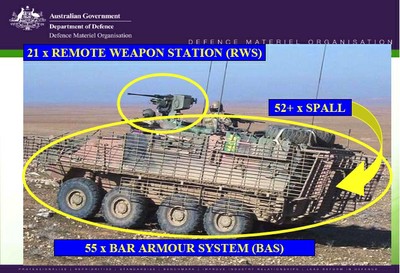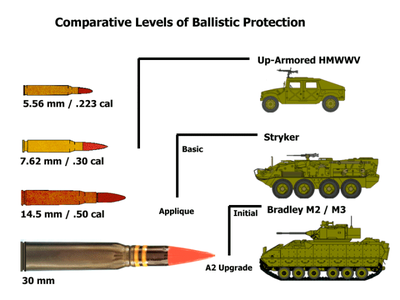ASLAV
24 May 2007
Government sources
Current Equipment – ASLAV Family, Department of Defence, Australia
Development of ASLAV variants in service with the Australian Defence Force
ASLAV-PC (Personnel Carrier)
The ASLAV-PC (Personnel Carrier) is used within the Regiment to provide tactical mobility to the Reconnaissance Scouts. The vehicle has a crew of two (driver and commander) and is capable of carrying eight Reconnaissance Scouts and their equipment. The ASLAV-PC is armed with a .50 cal machine gun which supplements the firepower provided by the ASLAV-25.
Source: Current Equipment, 2nd Cavalry Regiment (Recon), Australian Army
Project Land 112 ASLAV, Land Manoeuvre Systems and the Hardened and Networked Army, Brigadier Grant Cavenagh, Director General Land Manoeuvre Systems, Defence Materiel Organisation, Department of Defence, 2006
Planned upgrade of ASLAVs:
- “Acquisition of 144 Phase 3 vehicles
Standardisation of 113 Phase 2 vehicles
Acquisition of 59 Remote Weapon Stations and 9 Crew Procedural Trainers
Acquisition of 18 surveillance suites
Sole-source contract with General Dynamics Land Systems
Total Project value ~$1bn”
Land Project 112 ASLAV
Source: Department of Defence, 2006
Manufacturers
Stryker Light Armored Vehicles, General Dynamics Land Systems
“Today’s soldier must respond quickly to a full spectrum of operations anywhere in the world. Stryker answers that call. Manufactured by General Dynamics, Strykerad dresses today’s need for a fast, versatile, and survivable combat vehicle rapidly deployable by C-130 aircraft. As an integral part of Army Transformation, all ten Stryker variants combine maximum commonality and proven performance with lower operating and life cycle cost. The Stryker enables the soldier to achieve mission success quickly and decisively. Our troops deserve nothing less.”
vehicles, military (General Dynamics Land Systems). Team Australia, Defence Materiel Organisation, Department of Defence
“General Dynamics Land Systems – Australia (GDLS-A) is a strategic resource meeting the immediate needs of the Australian Defence Force and the New Zealand Army. With a world-class manufacturing facility in Pooraka, South Australia, and logistics centres in Darwin and Brisbane, GDLS-A is strategically positioned to provide quality production and logistics support throughout the region.”
Kongsberg Protector – Remote Weapon Station (PROTECTOR – RWS), Kongberg Gruppen
“PROTECTOR – Remote Weapon Station (PROTECTOR – RWS) is a remotely controlled weapon station for light and medium caliber weapons and can be installed on any type of vehicle.”
Analysis
ASLAV, Wikipedia
Comprehensive account of ASLAV development, specifications, variants, armaments and deployment.
Stryker Armored Vehicle, GlobalSecurity.org
Detailed account of US General Dynamics original, including ongoing development of ballistic protective capacities.
War machines saving Diggers, Ian McPhedran, Daily Telegraph, 25 April 2007
“The massive roadside bomb which hit an Australian patrol late on Monday would have destroyed the Humvees used by US troops. But the three Australian Light Armoured Vehicles withstood the impact of the bomb while on patrol north of the town of An Nasariyah in Dhi Qar Province, southern Iraq. They are made of reinforced steel and have specially fitted blast bars to withstand roadside bombs. Three Australian soldiers were injured in the attack, which happened at 6.30pm Baghdad time.”
Source: Stryker Armored Vehicle, GlobalSecurity.org
Protector M151, Wikipedia
General Dynamics Land Systems – Australia, Wikipedia
The ASLAV in Iraq, Tim Hales, Defender, Summer 2004-05
“In Iraq the ASLAV has adapted well to operations in the complex terrain of a major city. While the ?toughness? of its skin has been increased with the addition of spall liners, BAS and getting an ASLAV-PC crew commander out of harm?s way with a RWS, these simply augment the protection already inherent in a well-designed vehicle. These measures in turn are supplemented by the protection offered by a crew commander?s situational awareness, supported vehicle movement, and the ability for that crew commander to put his vehicle where his patrol needs him in relation to the enemy and a developing contact. A 13-tonne ASLAV-25 moving at highway speed searching for and tracking potential targets from a stabilised turret is a formidable sight to anyone on the ground and its ability to psychologically intimidate should not be underestimated.”
Australian Light-armoured Vehicles (ASLAV) as Mounted Cavalry: Vanguard for a Hardened Army, Lieutenant Colonel Roger Noble, Australian Army Journal, Volume II, Number 1, Winter 2005-2006.
Argument about the use of light armour in contemporary Australian overseas operations by a commander of the Al Muthannah Task Force. “Despite fielding arguably the best light-armoured vehicle in the world in the form of the ASLAV-3, developing robust doctrine for its use and generally leading the way in light cavalry thought and tactics for fifteen years, the Army still underestimates the potential of its own cavalry. The reasons for this underestimation are twofold. First, the Army possesses only one modern ASLAV cavalry regiment based in faraway Darwin. Second, there is a limited focus on cavalry in Australian military education and training. As a result, the role of cavalry in Australian military culture is ambiguous and does not fit easily into any particular conceptual framework.
“Yet, as we enter the Hardened and Networked Army (HNA) initiative—an initiative aimed at improving our combat firepower and protection—we must develop a better understanding of our organic light-armoured capabilities. The purpose of this article is to explain how ASLAV mounted cavalry, operating as part of a combined arms team, provide a multipurpose and combat organisation that is ideally suited for employment on the complex battlefields of the 21st century.”


